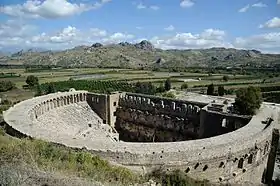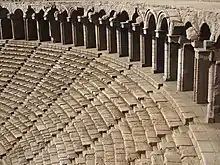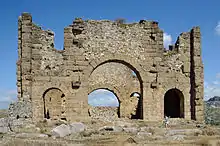Aspendos
Aspendos or Aspendus (Pamphylian: ΕΣΤϜΕΔΥΣ; Attic: Ἄσπενδος) was an ancient Greco-Roman city in Antalya province of Turkey. The site is located 7 kilometres (4.3 mi) northeast of central Serik.
Ἄσπενδος (in Ancient Greek) | |
 The Roman theatre in Aspendos has been preserved remarkably well.[1] | |
 Shown within Turkey | |
| Alternative name | Aspendus |
|---|---|
| Location | Serik, Antalya Province, Turkey |
| Region | Pamphylia |
| Coordinates | 36°56′20″N 31°10′20″E |
| Type | Settlement |
History
.JPG.webp)
_(2).jpg.webp)
.jpg.webp)

_(2).jpg.webp)
Aspendos was an ancient city in Pamphylia, Asia Minor, located about 40 km east of the modern city of Antalya, Turkey. It was situated on the Eurymedon River about 16 km inland from the Mediterranean Sea; it shared a border with, and was hostile to, Side.[2]
Some scholars associate the city's name with "Azatiwadaya". The known city of that name was founded by Azatiwada of Quwê on his eastern frontier, at Karatepe.[3] According to later tradition, Aspendos was founded rather earlier by Greeks who may have come from Argos.
The wide range of its coinage throughout the ancient world indicates that, in the 5th century BC, Aspendos had become the most important city in Pamphylia. At that time, according to Thucydides, the Eurymedon River was navigable as far as Aspendos,[4] and the city derived great wealth from a trade in salt, oil and wool.
Aspendos did not play an important role in antiquity as a political force. Its political history during the colonisation period corresponded to the currents of the Pamphylian region. Within this trend, after the colonial period, it remained for a time under Lycian hegemony. In 546 BC it came under Persian domination. The fact that the city continued to mint coins in its own name, however, indicates that it had a great deal of freedom even under the Persians.
Circa 465 BC Cimon led an Athenian navy against a Persian navy in the Battle of the Eurymedon, and destroyed it. Aspendos then became a member of the Delian League.[5]

The Persians captured the city again in 411 BC and used it as a base. In 389 BC Thrasybulus of Athens, in an effort to regain some of the prestige that city had lost in the Peloponnesian Wars, anchored off the coast of Aspendos in an effort to secure its surrender. Hoping to avoid a new war, the people of Aspendos collected money among themselves and gave it to the commander, entreating him to retreat without causing any damage. Even though he took the money, he had his men trample all the crops in the fields. Enraged, the Aspendians stabbed and killed Thrasybulus in his tent.
When Alexander the Great marched into Aspendos in 333 BC after capturing Perge, the citizens sent envoys asking him not to garrison soldiers there. He agreed, provided he would be given the taxes and horses that they had formerly paid as tribute to the Persian king. After reaching this agreement Alexander went to Side, leaving a garrison there on the city's surrender. Going back through Sillyon, he learned that the Aspendians had failed to ratify the agreement their envoys had proposed and were preparing to defend themselves. Alexander marched to the city immediately. When they saw Alexander returning with his troops, the Aspendians, who had retreated to their acropolis, again sent envoys to sue for peace. This time, however, they had to agree to very harsh terms; a Macedonian garrison would remain in the city and 100 gold talents as well as 4,000 horses would be given in tax annually.
In 190 BC the city surrendered to the Romans, and the corrupt magistrate Verres later pillaged its artistic treasures.[4][6] It was ranked by Philostratus the third city of Pamphylia, and in Byzantine times seems to have been known as Primopolis. Toward the end of the Roman period the city began a decline that continued throughout Byzantine times, although in medieval times it was evidently still a strong place.[4]
Diogenes Laërtius writes that there was a native of Aspendos called Demetrius who was a pupil of Apollonius of Soli.[7] In addition, he mentions the Diodorus of Aspendus.[8]
Greek and Roman structures

Aspendos is known for having the best-preserved theatre of antiquity. With a diameter of 96 metres (315 ft), it provided seating for 12,000.[9] It was built in 155[9] by the Greek architect Zenon, a native of the city. It was periodically repaired by the Seljuqs, who used it as a caravanserai, and in the 13th century the stage building was converted into a palace by the Seljuqs of Rum.[10]
In order to keep with Hellenistic traditions, a small part of the theatre was built so that it leaned against the hill where the Citadel (Acropolis) stood, while the remainder was built on vaulted arches. The high stage, whose supporting columns are still in place,[4] served to seemingly isolate the audience from the rest of the world. The 'scaenae frons' or backdrop, has remained intact. The 8.1 metre (27 ft) sloping reflective wooden ceiling over the stage has been lost over time. Post holes for 58 masts are found in the upper level of the theatre. These masts supported a velarium or awning that could be pulled over the audience to provide shade.[9]
The Aspendos International Opera and Ballet Festival offers an annual season of productions in the theatre in the spring and early summer.
Nearby stand the remains of a basilica, agora, nymphaeum and 15 kilometres (9.3 mi) of a Roman aqueduct. The Roman Eurymedon Bridge, reconstructed in the 13th century, is also in the vicinity.
Coinage

Aspendos was one of the earliest cities to mint coins. It began issuing coinage around 500 BC, first staters and later drachmas; "the slinger on the obverse represents the soldiery for which Aspendus was famous in antiquity,"[11] the reverse frequently depicts a triskelion. The legend appears on early coins as the abbreviation ΕΣ or ΕΣΤϜΕ; later coinage has ΕΣΤϜΕΔΙΙΥΣ, the adjective from the city's local (Pamphylian) name Estwedus. The city's numismatic history extends from archaic Greek to late Roman times.[12]
Bishopric
The Christian bishopric of Aspendus was a suffragan of the metropolitan see of Side, the capital of the Roman province of Pamphylia Prima, to which Aspendus belonged. Of its bishops, the names of four are recorded in extant documents: Domnus was at the First Council of Nicaea in 425, Tribonianus at the Council of Ephesus in 431, Timotheus at the 448 synod held by Flavian of Constantinople, which condemned Eutyches, and at the Robber Council of Ephesus held the same year, and Leo at the Second Council of Nicaea in 787.[13][14]
No longer a residential bishopric, Aspendus is today listed by the Catholic Church as a titular see.[15]
Aspendos International Opera and Ballet Festival
The theatre hosts the annual Aspendos International Opera and Ballet Festival organized by Turkish State Opera and Ballet since 1994, with international participation of opera and ballet companies and an audience of about 10,000.
Dalida held her last concert there on 28 April 1987.
References
- Andreae, Bernard (1977). The Art of Rome. New York: H. N. Abrams. p. 567. ISBN 0-8109-0626-0.
The Roman theater survives virtually intact... scarcely another surviving theater gives a better impression of just how the Roman theater - a solid single unified structure - differed from the Greek theater, which was made up of separate structures juxtaposed but each isolated and complete in itself.
- Barbara Burrell, Neokoroi: Greek Cities and Roman Emperors (Brill, 2004: ISBN 90-04-12578-7), p. 189.
- Ilya Yakubovich (2015). "Phoenician and Luwian in Early Iron Age Cilicia". Anatolian Studies. 65: 35–53. doi:10.1017/s0066154615000010., 50 from C. Brixhe (1976). Le dialecte grec de Pamphylie: documents et grammaire. Paris: Maisonneuve. pp. 80, 193.
- Hogarth, David George (1911). . In Chisholm, Hugh (ed.). Encyclopædia Britannica. 2 (11th ed.). Cambridge University Press. pp. 766–767.
- Holidays to Turkey info Archived 2012-01-11 at the Wayback Machine
- Cicero. In Verrem II. pp. 1. Chapter 53.
- DIOGENES LAERTIUS, LIVES OF THE PHILOSOPHERS, § 5.83
- DIOGENES LAERTIUS, LIVES OF THE PHILOSOPHERS, § 6.13
- Roth, Leland M. (1993). Understanding Architecture: Its Elements, History and Meaning (First ed.). Boulder, CO: Westview Press. ISBN 0-06-430158-3.
- Scott Redford, "The Seljuqs of Rum and the Antique," Muqarnas, Vol. 10, Essays in Honor of Oleg Grabar. (1993), p. 151.
- A Catalogue of the Greek Coins in the British Museum (British Museum. Dept. of Coins and Medals, 1897), p. lxxii.
- Asia Minor Coins – Greek and Roman coins of Aspendos
- Michel Lequien, Oriens christianus in quatuor Patriarchatus digestus, Paris 1740, Vol. I, coll. 1001–1002
- Pius Bonifacius Gams, Series episcoporum Ecclesiae Catholicae, Leipzig 1931, p. 450
- Annuario Pontificio 2013 (Libreria Editrice Vaticana 2013 ISBN 978-88-209-9070-1), p. 840
External links
| Wikimedia Commons has media related to Aspendos. |
- History of Aspendos
- Aspendos photos folder
- Maps of Aspendos
- How to go to Aspendos
- Plan of the Aspendos Antic Theater
- The Theatre at Aspendos, The Ancient Theatre Archive, Theatre specifications and virtual reality tour of theatre
- Livius.org: Aspendus
- Aspendos html5/full screen panoramas taken December, 2012
- Over 350 pictures from several visits
- Aspendos Archaeological Project 2008 –